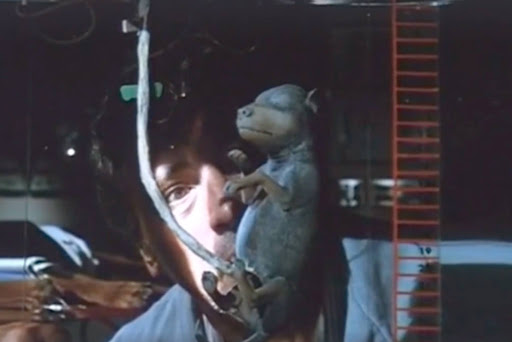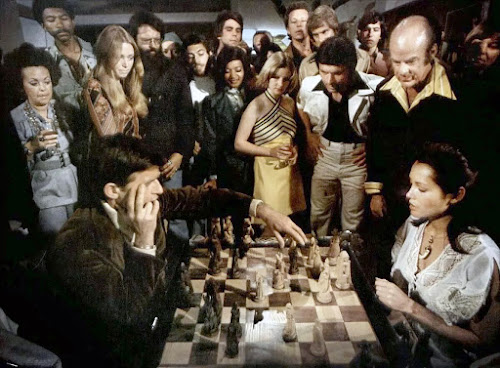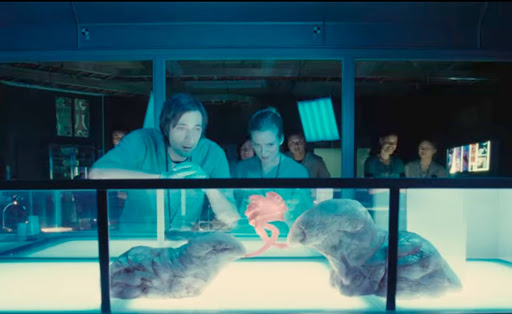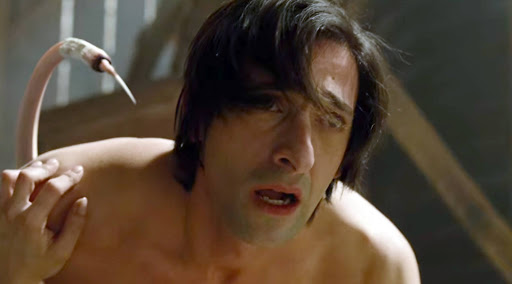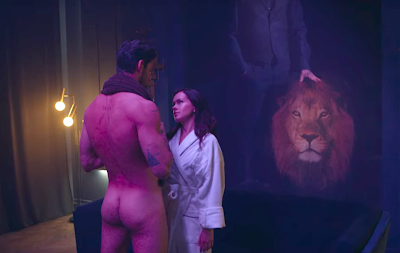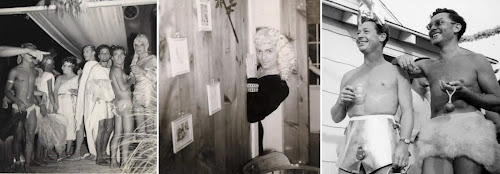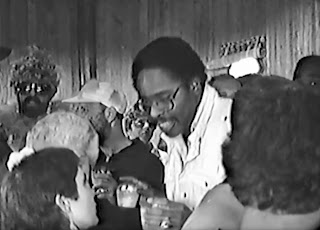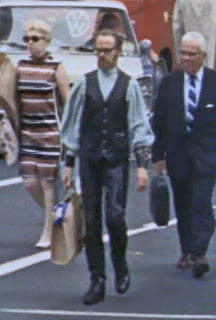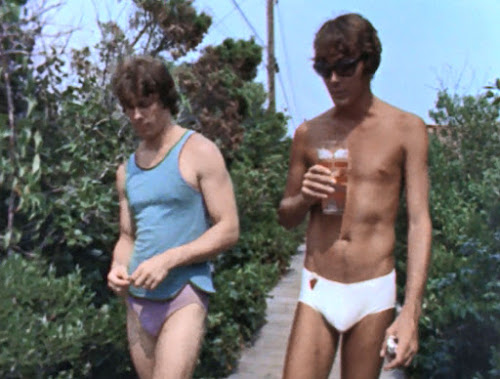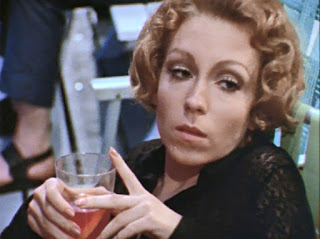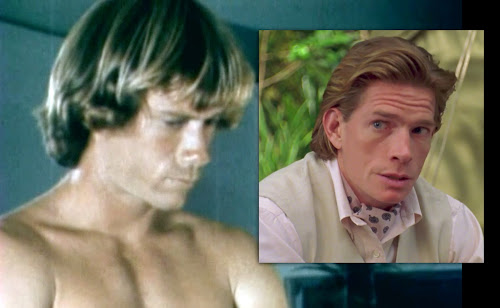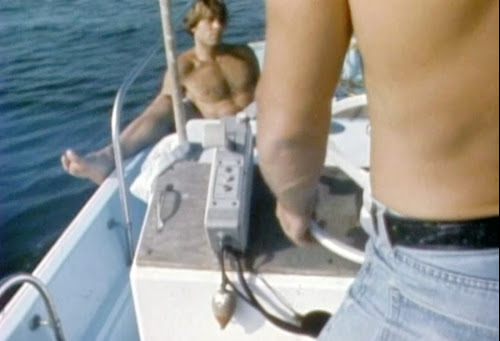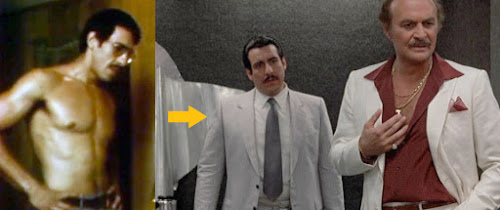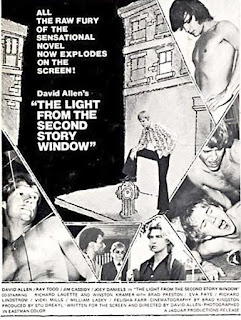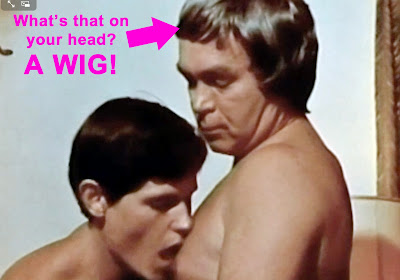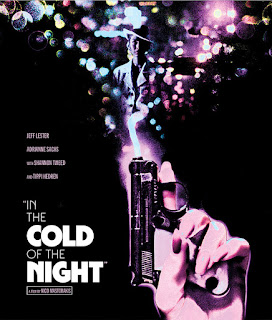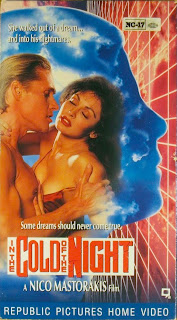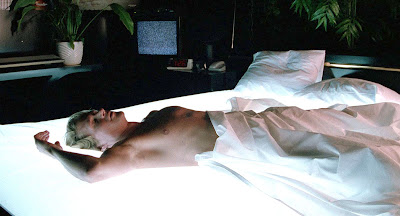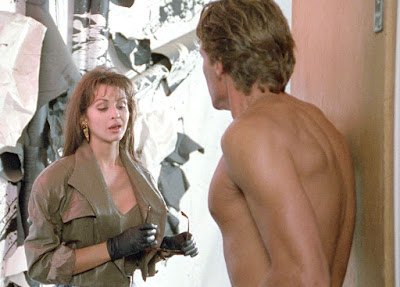June is Pride month, so what better way to celebrate than with classic gay porn? Actually, there are a lot of
better ways to celebrate Pride, but I watched an old gay porno film and it’s June, so…Happy Pride!
But the
old classic gay porno I watched isn’t just some compilation of Nova loops. No, this is a
movie, one about the moral compromises one young man makes in his pursuit of Hollywood stardom, a story brought to life by drag queens, cumshots and clowns. This is
THE LIGHT FROM THE SECOND STORY WINDOW, the 1973 showcase for its writer-director-star, David Allen.
Lee Jones (Allen) is “an innocent little boy from out of town,” who has taken a job with a mysterious Mr. Cury in Los Angeles. Meeting him at the bus station are Mr. Cury’s assistants, Karl (Winston Kramer), a perpetually annoyed soul brother, and Mother (Richard Lindstrom), a perpetually annoying drag queen. I’m not sure if the character of Karl was supposed to always be in a bad mood or if that was the only way Winston Kramer was capable of playing him. He rocks a big-ass pendant and does justice to a pair of tight, white pants, however, so we’ll let his one-note acting slide. More intriguing is Lindstrom as Mother. Looking like a genetic experiment that combines the DNA of Ruth Buzzi, Linda Belcher and an arachnid, Lindstrom puts his entire spindly body into each syllable Mother utters, making her look like a marionette controlled by a palsied puppeteer. Even RuPaul would be telling this bitch to tone it down. Yet, while I found Mother as irritating as Karl does, I couldn’t take my eyes off her, the same way you can’t look away from a gruesome car wreck.
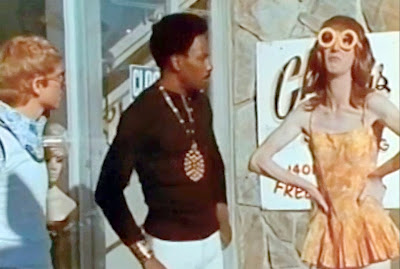 |
| Lee meets Karl and oh, Mother-fuck, no! |
But this isn’t Mother’s story, it’s Lee’s. After Mother flits off to buy a dress, Karl takes Lee back to a male whorehouse, where he has Lee wait outside (“You won’t run away, will you? You do, I’ll find you.”) while he goes off to do…something. Lee is left waiting with Alma, an older woman waiting for the titular light from the second story window that lets her know her manwhore is available. (“I’ve been waiting all day to get fucked,” she sniffs.) Alma is played by Ann Noble, writer and star of the 1972 movie
Sins of Rachel, who is bit of a question mark. Her IMDb page simply states she was an actress and writer, but her mannerisms and her penchant for high, Adam’s apple-concealing collars scream drag queen. Either way, you go girl!
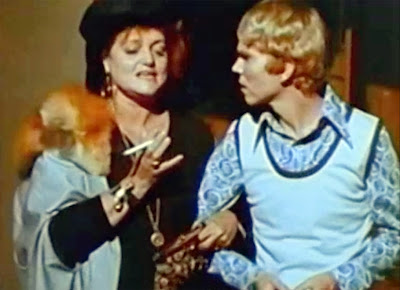 |
| Ann Noble turns on her womanly charms. |
That second story window finally lights up, but the available hustler is taken by a bewigged man appearing out of nowhere, pushing past Alma as he hurries up the stairs, rubbing his crotch and mumbling, “Gotta fuck.” This leads to the movie’s first sex scene. How hot is it? Well, if you’re into stilted twink-on-men-who-look-like-Linda Hunt action, prepare to paint the walls white. The rest of us are going to hit fast forward.
Meanwhile, Lee gets broken in by Karl, and is then put to work by the still unseen Mr. Cury. His first clients are a father and son (“I guess their philosophy was that a family that plays together, stays together,” Lee titters in a voice-over). Next, he services a closeted movie star whose house is the epitome of ’70s décor, with dark paneling, orange shag carpet and chairs and tabletops suspended by chains from the ceiling. The movie star is played by muscular Rick Cassidy, billed here as Jim Cassidy, who was a more
familiar presence in straight porn, including
The Danish Connection and
New Wave Hookers, the latter starring an underage Traci Lords. That he had done gay porn was a surprise to me (his other gay titles include
Desires of the Devil and
A Deep Compassion, which also starred Allen). Cassidy was certainly one of the better looking—and better built—men in straight porn, and he’s one of the best-looking men in
Second Story. It’s Cassidy’s body that elevates his scene with Allen, though it’s clearly a gay-for-pay situation.
 |
| Rick Cassidy knows how to make an entrance. |
Lee offers his body to another prominent Ric(k) from straight porn,
Ric Lutze, billed as Richard Lauette. Lutze plays a cop who shows up at Mr. Cury’s place during a dizzying orgy sequence that has Lee, a gold-faced clown and Mother, her dick a danglin’, treating the crowd to some performance art before the fucking commences. There’s so much reverb during this unwelcome bit of political theater that it’s often hard to understand what they’re saying, though I clearly heard the clown say the N-word, quickly followed by Lee wailing, “Down with racism!” I preferred watching the orgy, even if Stu Drexl, credited with directing the sex scenes, employs camera tricks that make the scene more headache inducing than erection producing.
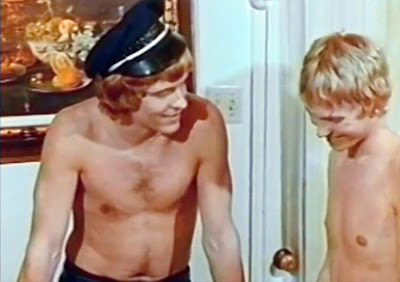 |
| “Hello, whore.” (Actual dialogue) |
Officer Lutze enjoyed pounding Lee’s tiny butt so much during that orgy that afterwards, when he meets with Mr. Cury (Stephen Lester, onscreen at last) to collect his protection fee, he pushes for a personal session with the young hustler. “I hate faggots,” the officer says, adding that Lee’s a “pretty lil’ shit, ain’t he?” The cop is thoroughly nasty in his treatment of Lee (“You don’t like cum in your face, huh? You love it!
You love it!”), and while
some fetishists [link NSFW] might consider such abuse foreplay, the mistreatment sends Lee over the edge. As Lee’s emotional breakdown scene edges toward
Lonely Lady territory, Mr. Cury shows up to jab a syringe full of nerve-calming smack into the sobbing blonde’s ass.
Second Story spends its second half on Lee clawing his way up from the depths of despair. This is also when David Allen indulges his writerly side. A middle-aged snake breeder (!), played by William Lasky, who had a career as a
second unit director in mainstream film and TV, finds a disheveled Lee wandering the streets of L.A. and takes him home. “You know, I’d really like to have sex with you,” says the man bluntly. Lee politely refuses (“I’m tired of being a whore”), and the man waxes philosophical about the compromises made by homosexuals:
“We conform to the world’s standards, to their laws, their ideas of right and wrong. … You know, we came to believe they knew best: homosexuals are evil creatures. And we swallowed it. Their destructive attitudes towards us made us destructive to ourselves, and then to each other. I always wanted a friend who accepted his homosexuality and who could help me accept mine. … That’s it, you know: to love without the need for darkness, without caring about them.”
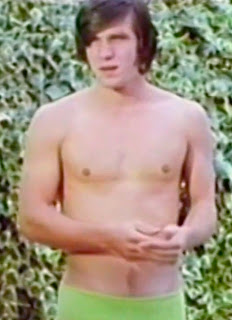 |
Ray Todd demonstrates his mastery of
the huh? facial expression. |
Pretty heavy for a dirty movie, though at this point the
Second Story appears to forget it’s porn as forty minutes pass before the next sex scene. Lee, after making one more fuck flick for Mr. Cury (his porn films are referenced frequently in dialog, but Lee is never shown appearing in one), finally gets his big break in a legit movie, also courtesy of Mr. Cury. So, I guess in the world of
Second Story, talent agents are also pimps? Sounds about right. Anyway, Lee becomes a huge star, and befriends Alma’s young cousin Chuck (sure), whom he meets during a celebratory gathering at the Sunseteast [sic] Showbar. “Careful, darling, he’s straight,” Alma warns.
Of course, Lee is immediately smitten, and it’s easy to see why. Chuck is played by Ray Todd, who vaguely resembles
Warhol star Joe Dallesandro, and who can be counted among the best-looking performers in the movie. Unfortunately, though Todd has the sex appeal of Dallesandro, he possesses neither Dallesandro’s charisma nor his acting ability, limited though it may be. As portrayed by Todd, Chuck is not only straight as a board, he has the emotional range of one, too. So, as much as I want to ridicule the decision to have Chuck, over at Lee’s house for a swim, remove his Speedo because he’d “feel more free-er” [sic], I’ll instead praise Allen’s directorial choice for realizing where Todd’s talents lie and getting him naked as quickly as possible.
Lee’s attempts to help Chuck discover his inner bisexual fail, so the movie star hires a hustler, Big John (Joey Daniels). “Nice place you got here,” the blonde rent boy remarks upon entering Lee’s home, a comment that had me wondering what sort of shitholes his other clients lived in as Lee’s house is just a dowdy 1940s-era three-bedroom. The set for Mr. Cury’s whorehouse was more befitting a movie star. Anyway, after Lee asks his houseboy to bring drinks (beer for Big John, Champale for Lee), Big John gets down to business. “What do you like to do? Suck cock?” No, Lee couldn’t be that easy. He wants to
talk. “Life is not always a basket of meat,” Lee explains. Undaunted, Big John strips so Lee can “inspect the merchandise” (for the record, he ain’t that big, but maybe he’s a grower, not a show-er), becoming indignant when Lee still shows no interest in sex. “When you’re in the fucking business and your body doesn’t sell, where do you go?” Big John asks. He storms off, leaving behind the $20 Lee paid him.
Lee returns to Mr. Cury’s brothel, this time as a client. He’s dismayed when Chuck arrives, wanting to work for Mr. Cury, but that doesn’t stop Lee from being Chuck’s first client. Allen clearly enjoys himself during this final sex scene, but Todd is as exciting a sexual performer as he is an actor, no doubt maintaining his hard-on thinking about how he’d spend his paycheck. He’s easy on the eyes, nevertheless.
During their post-fuck conversation, Lee makes one final plea for Chuck to be his lover, but Chuck resists. The movie ends with Lee, outside the theater premiering his latest movie, wondering if fame was worth the price he had to pay.
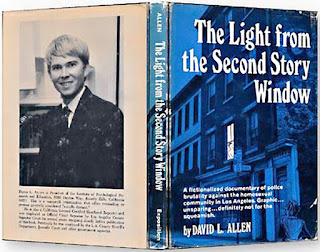
The Light from the Second Story Window is actually an adaptation of a 1972 novel of the same name—David Allen’s novel. I can’t speak to Allen as a novelist (the cheapest copy of his book I could find was just shy of $90, so, no, I’m not reading it), but he could’ve used some guidance with his screenplay and, by extension, his directing. He clearly had a lot of ideas he
wanted to express, and he was going to express every fucking one, tone,
pacing and budget limitations be damned. With a nearly two-hour
runtime, Second Story is half campy melodrama, half hardcore porn movie, and the two halves, unsurprisingly, don’t coexist easily. When you follow a facial with police brutality, a
nervous breakdown and a monologue about the loneliness of being a
homosexual, you’ve pretty much killed the mood. Though, too be fair,
none of the sex scenes are particularly arousing. Between gay-for-pay
performers going through the motions and performers who, politely put, are less than photogenic, it’s a porn film that defies masturbation. (Allen was
too much of a twink for my tastes, but I will give him props for being
appropriately enthusiastic in his sex scenes, though, interestingly, he
never got hard in any of them. His scene with Lutze might have been the
hottest in the whole movie had Lutze’s character not been so
despicable.)
Which begs the question, why was Second Story a hardcore porn movie at all? Wouldn’t it have worked better as a softcore film? It would, but I suspect the decision to go hardcore was a commercial one. Allen was already in the porn biz, and a gay porn film was virtually guaranteed to at least break even in the early ’70s. A low-budget drama about a gay man trying to make it in Hollywood? Not so much.
Second Story is more of an adult film curiosity than porn classic, but it’s still worth checking out to get a glimpse into gay life of its era. I just wish I could find out more about the making of the movie. Unfortunately, most of the people connected with it have either died (Lutze, Cassidy, Lasky) or just disappeared. Second Story was Allen’s swan song, but if he’s still with us I’d love to hear about his experience making the movie and why he quit just as he was getting started.
ADDENDUM: I was tooling around the internet, researching for a Halloween 2021 post, when I stumbled upon what is now my new favorite podcast, Ask Any Buddy, hosted by film historian Elizabeth Purchell (who directed a film of the same name) and Tyler Thomas. In each episode the pair review and discuss gay porn movies made between 1968 and 1986, including The Light from the Second Story Window. It’s a fascinating listen, revealing that this movie’s original runtime was three hours (!), that Ann Noble was indeed a woman, that the cast was almost wholly comprised of members of the Society of Pat Rocco Enlightened Enthusiasts (SPREE), and that Stu Drexl was, in fact, Pat Rocco. I don’t necessarily agree with their assessment of Ray Todd as an actor and sexual performer (really, you thought he was good?), but we agree on the movie as a whole. Ask Any Buddy also discusses Tom De Simone’s The Idol, which I’ve also reviewed.

